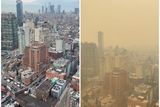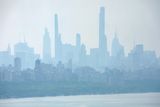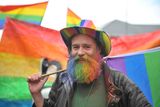Irish students looked on in disbelief as New Yorkers’ famed resilience vanished under a smoky cloud



First the sky became hazy and Dr Marcus Collier was taken back to the bad old days in 1980s Dublin when winter smog hung thick over the choking city.
Then it turned brown and he was reminded of a visit to Yellowstone Park in the US when the ominous colours overhead signalled a devastating blaze at a time when major wildfires were still rare.
He was sharing these thoughts with his students when the distinctive smell of burning started to creep in.
“And sure enough, about an hour and a half later, we looked out and everything was mustard yellow and it was tough to breathe,” said Dr Collier.
New York city’s blue-sky summer had been enveloped in smoke from wildfires burning hundreds of kilometres away in Canada.
Read more
Dr Collier, associate professor of sustainability science at Trinity College Dublin, was in New York with a group of PhD students.
He was struck by how shaken New Yorkers were by the experience.
“I would have said they would withstood anything,” he said. “I was here 38 years ago and I remember a hurricane came through and there were people out doing their shopping, not a bother on them.
“But they didn’t think this could happen. It caught them completely off guard. It wasn’t even forecast.
“It was like our volcanic ash cloud a few years ago. It came out of nowhere and they were scared. For them, this happens in California – not here.”
Dr Collier’s group of students were working on an EU-funded project, NovelEco, which is gathering information about wild places in urban spaces.
They were several days into their trip, meeting community groups, environmentalists, artists and guerilla planters.
They were logging nature’s determined forays into vacant lots, pavement cracks and other untended places when their schedule was interrupted.
“The city authorities asked people to stay in and they cancelled schools and games and asked people not to go jogging and to take extra care with pets.
“It was effectively a lockdown and when we met up with the local groups on Thursday, when the worst of the smoke had passed, there were some very emotional people. Everyone was wearing face masks and was cautious.
“I was quite surprised because New Yorkers are normally so resilient.
“But we’re working in a poor area – many people here are on food stamps – and a lot of people were concerned because the cost of healthcare here is so high, they can’t afford to get sick. So there was genuine anxiety.”
Despite the trope that poor people can’t afford to worry about climate change, Dr Collier found the exact opposite is the case.
“Climate change was definitely part of the conversation. For New York, fires are not an issue so much as sea-level rise.
“A huge proportion of the city is very close to sea level and it also happens to be the poorest part so there’s a climate justice issue.
“What happened this week made that very clear.
“It’s disproportionately affecting poor people, people with breathing difficulties and elderly people – people who can’t just get into a car and drive away or can’t afford good air conditioning or may not be able to react as fast as others.
“What’s worrying is that this is not an outlier. It will be happening more and more.
“Lockdowns, facemasks, health problems – what we experienced as a consequence of disease is going to be a feature of our existence in many parts of the world because of climate change, even in our own country.
“It probably won’t be as severe in Ireland but if the wind was blowing differently from France or England or Scotland, we could just as easily get what we’ve had in New York this week in certain parts of Dublin and Belfast.”
Despite the unexpected interruption, the NovelEco research outings and meetings proved invaluable.
“A woman asked us were there black plants in Black neighbourhoods and white plants in white neighbourhoods,” he said. “She was asking does affluence and culture determine what nature you get. That’s such an important question for us all.”
Dr Collier leaves New York tomorrow for meetings in Quebec, Canada, so he’ll be moving closer to the source of the problem.
“Colleagues there have been telling me to be prepared but I find it very sad that this is now something we have to prepare for.”













